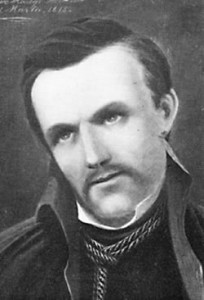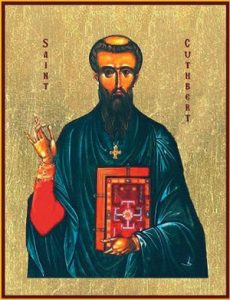March Saints
 Saint John Ogilvie (1579-1615)
Saint John Ogilvie (1579-1615)
Born in 1579, John Ogilvie belonged to Scottish nobility. Raised a Calvinist, he was educated on the continent. In 1596, at age seventeen he was received into the Church at Louvain. Later John attended a variety of Catholic educational institutions, and eventually he sought admission into the Jesuits. He was ordained in Paris in 1610 and asked to be sent to Scotland, hoping some Catholic nobles there would aid him, given his lineage. Finding none, he went to London, then back to Paris, and finally returned to Scotland. John’s work was quite successful in bringing back many people to the Faith.
Some time later he was betrayed by one posing as a Catholic. After his arrest he was tortured in prison in an effort to get him to reveal the names of other Catholics, but he refused. After three trials, John was convicted of high treason because he converted Protestants to the Catholic Faith as well as denying the king’s spiritual jurisdiction by upholding the Pope’s spiritual primacy and condemning the oaths of supremacy and allegiance. Sentenced to death, the courageous priest was hanged in Glasgow in 1615 at the age of thirty-six.
Saint John, help us to be true to our faith and principles, even in the face of persecution.
(Source: http://www.catholic.org/saints/saint.php?saint_id=820)
 Blessed Giuseppina Catanea
Blessed Giuseppina Catanea
(1894-1948)
Guiseppina Catanea was born in Naples in 1894 into a noble family. Even as a child, she followed the example of her mother and grandmother in showing great affection for the poor and the most needy. At an early age, too, she felt God was calling her to Carmel. Her mother and family opposed this idea, so Pinella, as she was known, completed a course in commercial studies.
In due time, she managed to overcome the family opposition and in 1918 entered the Carmelite Community at St Maria a Ponti Rossi. As a young religious, she learned to love Christ through suffering. Offering herself as a victim for the good of priests, she accepted great physical pain as God’s will for her. Afflicted with tuberculosis of the spine which completely paralysed her for a time, she was cured through the intercession of St Francis Xavier, whose relic was brought to her cell and who appeared to her in a dream. This miraculous recovery became known outside the community and brought priests, seminarians and people of every social class to Ponti Rossi to receive counsel and consolation from her, even though she would much rather have lived in solitude and silence.
In 1932, the Holy See officially recognised the house at Ponti Rossi as a convent of the Discalced Carmelites, with papal enclosure. Guiseppina received the Carmelite habit and took the name Sister Maria Guiseppina of Jesus Crucified. On the day she took the habit, she said that she wished to offer herself to the Crucified Jesus so that she could be crucified with Him - and God took her at her word.
On 6 August 1932, she made her Solemn Profession according to the Carmelite Rule and two years later she was appointed Sub-Prioress, becoming Vicar in 1945. That same year, on 29 September, the first General Chapter of the Pinto Rossi Carmel elected her Prioress, an office she held till her death in 1948.
Already in 1943 she had begun to suffer various physical illnesses, including the progressive loss of her sight. She suffered silently but joyfully and abandoned herself to the will of God, who favoured her with mystical experiences. She considered her illnesses to be ‘a magnificent gift’ that allowed her to be better conformed to the Crucified Christ and with a cheerful spirit she offered her body as a sacrifice for souls.
Blessed Giuseppina, teach us to suffer willingly for the salvation of souls.
(http://www.vatican.va/news_services/liturgy/saints/2008/ns_lit_doc_20080601_josefina-catanea_en.html)
Cuthbert is believed to have been a Briton or a Scot. After entering Melrose Abbey in Northumbria in 651, he became prior at the monastery in 661 after an outbreak of the plague, during which he reportedly performed miracles. In 685, he was ordained abbot-bishop of Lindisfarne.
After years of preaching and evangelising, Cuthbert became a hermit. He spent the last two years of his life caring for plague victims, working miracles and announcing prophecies. He died at Lindisfarne, and his body remained incorrupt.
Saint Cuthbert, obtain for us the grace to persevere in helping those in need.
(Encyclopedia of the Saints, Matthew, Margaret & Stephen Bunson.1998 Our Sunday Visitor Publishing, Indiana

 Entries(RSS)
Entries(RSS)